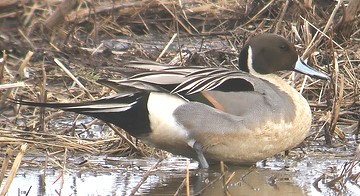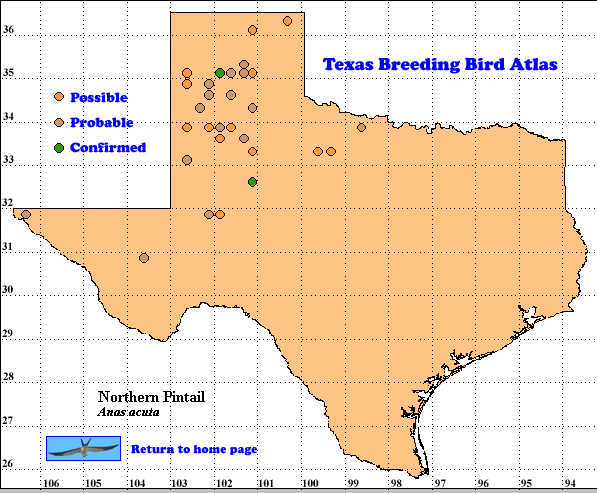Most Northern Pintails are raised on tundra ponds, prairie potholes and similar aquatic habitats, after hatching in ground nests, usually on arctic tundra, prairie grasslands or agricultural fields. These nests are subject to predation because of their visibility, or loss to farming operations when placed in agricultural fields. After breeding, adults gather on shallow wetlands and flooded agricultural fields to replace their flight feathers. Fall migration begins following molt and pintails are among the earliest waterfowl to move. They return in late winter to begin the breeding cycle before most other ducks (Austin and Miller 1995).
DISTRIBUTION. During the 1987-1992 field work seasons of the TBBA project, atlasers found 2 confirmed, 14 probable and 17 possible breeding sites for Northern Pintail, primarily on the High Plains (see the region map in Lockwood and Freeman [2004]). These authors described this duck as rare to locally uncommon in the areas shown on the TBBA map. In Oklahoma atlasers found 8 probable nesting records and a post-atlas nest. Six of these sites were in their panhandle (Fantina 2004) .
In North America the most common areas for pintail breeding are in the Arctic tundra of Alaska and northern Canada, the Canadian prairie provinces, the Dakotas, northern Montana, northern Utah, central Nevada and the Klamath Basin of Oregon and California. These ducks winter primarily in southwest Canada, much of the western and southern United States, its Atlantic coast, Cuba and Mexico. Other populations occur in Europe, Asia, north Africa and some islands of the western Pacific Ocean (Stiles and Skutch 1989, Austin and Miller 1995, Howell and Webb 1995, Am, Ornithol. Union 1998, Sauer et al. 2008).
SEASONAL OCCURRENCE. Northern Pintail is a locally uncommon to abundant winter resident throughout Texas. Most spring migrants leave between mid-February and the end of March. In Colorado atlasers found fledged young from June 3 to August 1, suggesting a breeding season starting at least as early as April. Migrant pintails begin arriving in in Texas late July and early August with most wintering pintails here by lat September (Austin and Miller 1995, Boyle 1998, Lockwood and Freeman 2004).
BREEDING HABITAT. In Colorado atlasers found about 80% of Northern Pintail fledged young at lakes (Boyle 1998). Similar habitats are probably used in Texas as foraging and brooding areas for the precocial young. Across the range of pintails, nests are usually placed where vegetation is low or sparse, as in stubble fields, prairies, hayfields, planted croplands and open grasslands. The nest is built in a natural depression or one dug by the female in about 4 days. It is often far from water and is constructed of leaves, sticks and dry grass, intermingled with down feathers. The outside diameter is 19-26 cm (7.5-10 in), inside diameter 13-19 cm (5-7.5 in) and height above ground 0-18 cm (0-7 in; Harrison 1979, Austin and Miller 1995).
Here the female lays about 7 (range 3-12) pale olive-green to pale olive-brown eggs, one per day. These eggs are almost indistinguishable from those of Mallard (A. platyrhynchos) or Northern Shoveler (A. clypeata). They are intermediate in size between the eggs of these two species. She incubates her eggs for 22-24 days. The male departs to molt during this time. She leads the precocial young (capable of feeding on aquatic insects) to water shortly after the brood hatches. The hen remains with the ducklings until they can fly, about 4-6 weeks after hatching (Harrison 1979, Austin and Miller 1995).
STATUS. Northern Pintails are rare to locally uncommon summer residents in the Panhandle and areas to the south (Lockwood and Freeman 2004). The map in Oberholser (1974) shows only 3 county breeding and 12 summer records in this area, the same area where the North American Breeding Bird Survey (BBS) found a relative abundance of <1 pintail per 40 km (25 mi) route per year. Although data from the 8 BBS routes in Texas on which this duck was observed are inadequate to produce a biologically meaningful trend, data from 381 routes across North America for 1980-2007 suggest an annual population change of less than -1% per year (Sauer et al. 2008). This small annual change and the size of the wintering population in Texas suggest this species will continue to be available for Texas birdwatchers to enjoy for many years.
Text by Robert C. Tweit (2008)
Literature cited.
American Ornithologists’ Union. 1998. Checklist of North American birds, 7th ed. Am, Ornithol. Union, Washington, DC.
Austin, J E. and M. R. Miller. 1995. Northern Pintail (Anas acuta), The Birds of North America Online (A. Poole, Ed.). Ithaca: Cornell Lab of Ornithology; Retrieved from: http://bna.birds.cornell.edu/bna/species/163
Boyle, S. 1998. Northern Pintail (Anas acuta). In Colorado breeding bird atlas, pp. 84-85 (H. E. Kingery, ed.), Colorado Bird Atlas Partnership, Denver.
Fantina, D. E. 2004. Northern Pintail (Anas acuta). In Oklahoma breeding bird atlas, pp. 76-77 (D. L. Reinking, ed.). University of Oklahoma Press, Norman.
Harrison, H. H. 1979. A field guide to western birds’ nests. Houghton Mifflin, Boston, MA.
Howell, S. N. G. and S. Webb. 1995. A guide to the birds of Mexico and northern Central America. Oxford University Press, New York.
Lockwood, M. W. and B. Freeman. 2004. The TOS handbook of Texas birds. Texas A&M University Press, College Station.
Oberholser, H. C. 1974. The bird life of Texas. University of Texas Press, Austin.
Sauer, J. R., J. E. Hines, and J. Fallon. 2008. The North American breeding bird survey, results and analysis 1966-2007. Version 5.15.2008. USGS Patuxent Wildlife Research Center, Laurel MD < http://www.mbr-pwrc.usgs.gov/bbs>
Stiles, F. G. and A. F. Skutch. 1995. A guide to the birds of Costa Rica. Cornell University Press, Ithaca, NY.

